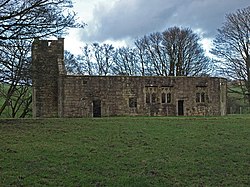Castle Semple Collegiate Church
| Castle Semple Collegiate Church | |
|
Renfrewshire | |
|---|---|
 Castle Semple Collegiate Church | |
| Type: | church |
| Location | |
| Grid reference: | NS37566011 |
| Location: | 55°48’25"N, 4°35’37"W |
| History | |
| church | |
| Gothic | |
| Information | |
| Condition: | ruined |
| Owned by: | Historic Scotland |
| Website: | Castle Semple Collegiate Church |
Castle Semple Collegiate Church is a ruined church by the north shore of Castle Semple Loch in Renfrewshire. It is near the eastern end of the loch, within Clyde Muirshiel Regional Park, and two miles west of Howwood (on the B787, then on to the B776).
The church was built around 1504, in the late Gothic style, as a collegiate church, with is to say that it had a group of clerics to govern it. The church is 71½ feet in length; 24¼ feet in width; and 15½ feet in height.
Today it is under the protection of Historic Scotland, and is also a scheduled monument.[1]
History
John Sempill, 1st Lord Sempill founded the church on his estates in around 1504. It had a provost, six chaplains or prebendaries, two boys, and a sacristan. King James IV of Scotland visited John's house at Eliotston and the collegiate church on 26 July 1505 and the king gave an offering of 14 shillings in the "New College."[2] A stone in the outer wall bears the letters 'R. L. S.', and the arms of Sempill and Montgomerie.
The walls of the church today are covered with ivy. The roof was removed in the 1800s, and the ivy has penetrated into the interior. In ancient times, there appears to have been a village at this place, and a chapel in its neighbourhood dedicated to St Bride.[3]
Design and architecture

The building is a simple oblong, terminating toward the east in a three-sided apse, and having a square tower projecting from the centre of the west wall. The forms of the double windows indicate that they are very late survivals of Gothic architecture. The other windows in the side walls are altered, but they do not present any features like those of the apse.
Over the door to the chancel are two coats of arms with the letters 'R. L. S.' and 'A. M. S.', one shield bearing the Sempill arms and the other those of Montgomerie.
The square tower at the west end is extremely simple. The tower and most of the side walls are of about the date of the original foundation, while the east apse has been added in the 16th century, to receive the monument of John, Lord Sempill, who died at the Battle of Flodden in 1513.
A few remains of the original squareheaded windows in the side walls are still traceable. The interior was divided by two solid walls into three compartments, so as to form separate private burial places. In the eastern compartment, there is a large monument to Lord Sempill. A monumental slab in the central compartment is erected in memory of Gabriel Sempel, who died in 1587.[4]
Outside links
| ("Wikimedia Commons" has material about Castle Semple Collegiate Church) |
- CANMORE (RCAHMS) record of Castle Semple Collegiate Church
- Castle Semple Collegiate Church
- Castle Semple Collegiate Church, Village & St Bride's Chapel - YouTube
References
- ↑ Castle Semple Collegiate Church - scheduled monument detail (Historic Environment Scotland)
- ↑ Accounts of the Lord High Treasurer of Scotland, vol.3 (1901), p.xviii, 62
- ↑ Fullarton, A. (1853). The Topographical, statistical, and historical gazetteer of Scotland: with a complete county-atlas from recent surveys, exhibiting all the lines of road, rail, and canal communication; and an appendix, containing the results of the census of 1851 (Public domain ed.). A. Fullarton. pp. 217–. https://books.google.com/books?id=BIHRAAAAMAAJ&pg=PA217. Retrieved 7 December 2011.
- ↑ MacGibbon, David; Ross, Thomas (1897). The ecclesiastical architecture of Scotland from the earliest Christian times to the seventeenth century (Public domain ed.). D. Douglas. pp. 351–. https://books.google.com/books?id=6KQaAAAAYAAJ&pg=PA351. Retrieved 7 December 2011.
- Fullarton, A.: 'The Topographical, statistical, and historical gazetteer of Scotland' (1853)
- MacGibbon, D.: 'The ecclesiastical architecture of Scotland from the earliest Christian times to the seventeenth century' (1897)
